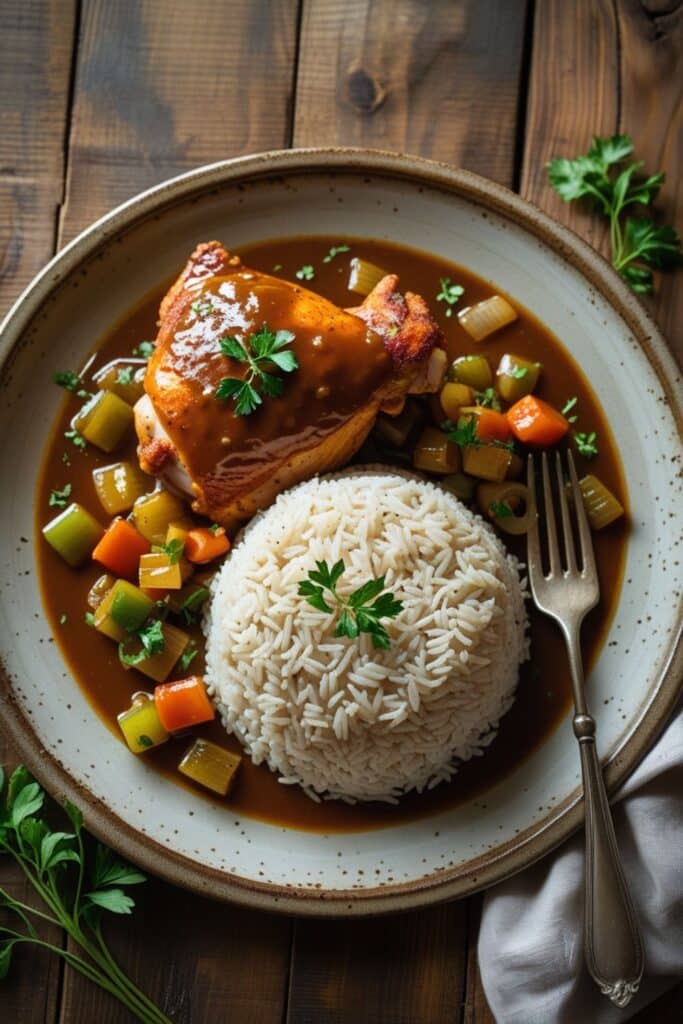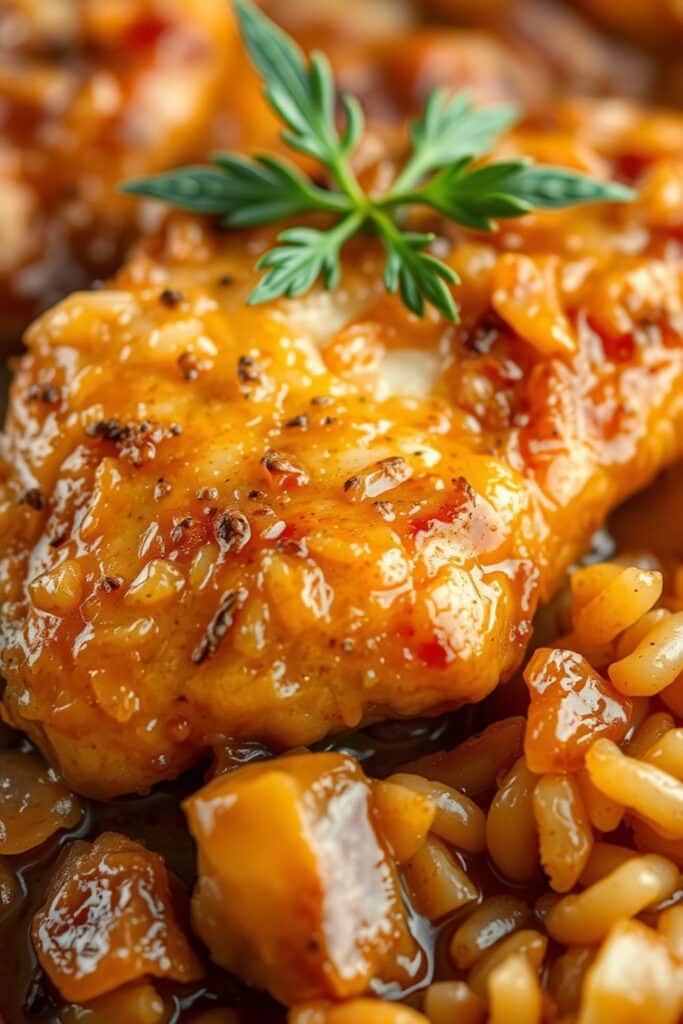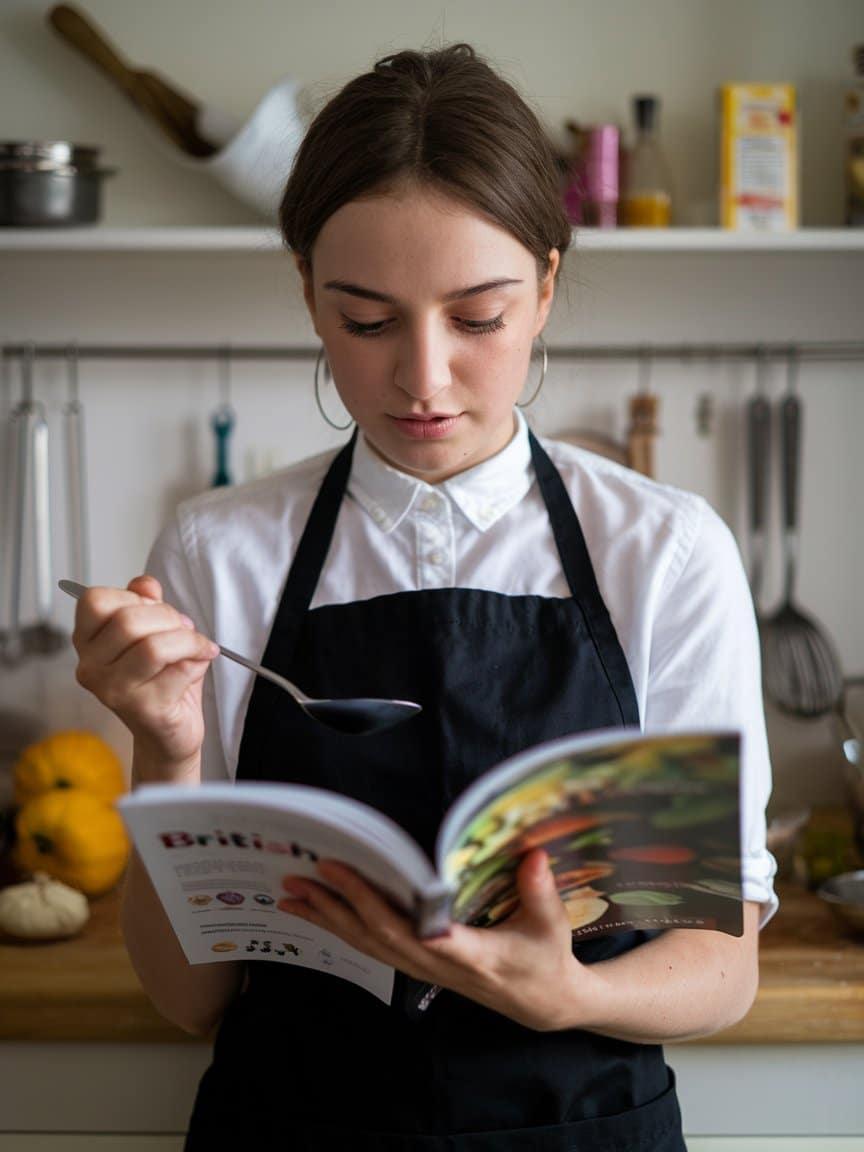Last Tuesday, I watched a young line cook struggle with what should’ve been simple smothered chicken. The sauce broke, the rice turned mushy, and the chicken came out dry as cardboard. It reminded me why this seemingly humble dish separates true cooks from mere recipe followers.
Smothered chicken and rice isn’t just comfort food it’s a masterclass in foundational cooking techniques disguised as soul food. This Louisiana-born dish demands respect for the holy trinity of vegetables, understanding of roux formation, and precise liquid management. When executed properly, it transforms modest ingredients into something transcendent.
The magic lies in the smothering technique itself. Unlike braising or stewing, smothering creates an intimate relationship between protein, aromatics, and liquid that results in fall-apart tender chicken enveloped in silky, flavor-packed gravy. The rice becomes more than a side it’s the canvas that absorbs every nuance of the sauce.
Understanding the Foundation
The technique originated in rural Louisiana kitchens where cooks needed to stretch ingredients and create filling meals from tough cuts of meat. Smothering tenderizes through low, slow cooking while building layers of flavor that would make even premium cuts jealous.
What sets authentic smothered chicken apart is the marriage of French technique with Creole sensibilities. The roux provides richness and body. The holy trinity onions, celery, and bell peppers creates aromatic depth. The long, gentle simmer transforms tough connective tissue into gelatin that gives the sauce its characteristic silky mouthfeel.
Professional kitchens often overlook this dish because it can’t be rushed. But that’s exactly why it belongs in your repertoire it teaches patience and rewards proper technique in ways that flashier dishes simply can’t.
Ingredients & Substitutions
For the Chicken:
- 3-4 pounds bone-in chicken thighs and drumsticks
- 2 teaspoons kosher salt
- 1 teaspoon black pepper
- 1 teaspoon paprika
- ½ teaspoon garlic powder
- ½ teaspoon onion powder
For the Base:
- ¼ cup vegetable oil or lard
- ¼ cup all-purpose flour
- 1 large yellow onion, diced
- 1 bell pepper, diced
- 2 celery stalks, diced
- 4 garlic cloves, minced
- 2 bay leaves
- 1 teaspoon fresh thyme (or ½ teaspoon dried)
For the Liquid:
- 3 cups chicken stock
- 1 cup water
- 2 tablespoons Worcestershire sauce
- 1 tablespoon hot sauce (Crystal or Louisiana-style)
- Salt and pepper to taste
For the Rice:
- 2 cups long-grain white rice
- 3½ cups chicken broth
- 1 tablespoon butter
- 1 teaspoon salt
Smart Substitutions
Chicken thighs and drumsticks aren’t negotiable their higher fat content and connective tissue are essential for proper smothering. However, if you must use breasts, reduce cooking time significantly and accept that you’re making a different dish entirely.
The holy trinity vegetables can be adjusted but shouldn’t be eliminated. Short on celery? Double the onions. No bell peppers? Use poblanos for heat or fennel for sweetness. But maintain that 2:1:1 ratio of onions to celery to peppers it’s the foundation of Louisiana cooking.
Lard creates superior flavor and texture in the roux, but vegetable oil works fine. Avoid olive oil its low smoke point will give you bitter flavors. For the stock, homemade is ideal, but high-quality commercial stock beats water every time.
Long-grain rice is crucial for texture. Short-grain varieties turn mushy under the sauce’s weight. Jasmine rice works well, but avoid instant rice it lacks the structure needed to support the dish’s rich flavors.
Step-by-Step Instructions

Preparing the Chicken Foundation
Season chicken pieces generously at least 30 minutes before cooking. This isn’t just about flavor salt draws out moisture that would otherwise create steam and prevent proper browning. Pat pieces completely dry before cooking.
Heat oil in a heavy-bottomed Dutch oven over medium-high heat. The vessel matters here thin pots create hot spots that burn your roux. Brown chicken pieces in batches, skin-side down first. Don’t crowd the pan, and resist the urge to move pieces too quickly.
Look for deep golden-brown color with crispy edges this is where your flavor foundation begins. The fond left behind becomes part of your sauce’s complexity. Remove chicken and set aside, leaving the rendered fat in the pot.
Building the Roux
Reduce heat to medium and add flour to the remaining fat. If you don’t have enough fat, add oil to make about ¼ cup total. This is your moment of truth roux can’t be rushed or salvaged once burned.
Stir constantly with a wooden spoon or whisk. The mixture will bubble and foam initially, then gradually darken. For smothered chicken, you want a blonde to light brown roux darker than for gumbo but lighter than étouffée. This takes 8-12 minutes of constant stirring.
The roux is ready when it smells nutty and has the color of peanut butter. If you see black specks or smell anything acrid, start over. There’s no saving burnt roux, and it’ll ruin your entire dish.
Vegetable Integration
Add the holy trinity to your finished roux immediately. The vegetables’ moisture will stop the browning process and prevent burning. Stir constantly as they sizzle and steam.
Cook until vegetables soften and onions become translucent, about 8-10 minutes. Add garlic in the final minute it burns easily and becomes bitter if added too early. This base mixture is called a sofrito in some circles, and it’s the soul of your dish.
Season with bay leaves and thyme now. These hardy herbs need time to release their oils and meld with the other flavors. Fresh thyme is worth seeking out its bright, earthy notes complement the rich roux beautifully.
Liquid Dynamics
This step separates professionals from home cooks. Add stock gradually, whisking constantly to prevent lumps. Start with one cup, whisking until smooth, then add remaining liquid in steady stream while whisking.
The mixture should come together smoothly without lumps. If you do get lumps, strain the sauce through a fine-mesh sieve better to lose a little texture than serve grainy gravy. Add Worcestershire and hot sauce, then taste for seasoning.
Return chicken pieces to the pot, skin-side up. The liquid should barely cover the chicken too much dilutes flavors, too little causes scorching. Bring to a gentle simmer, then reduce heat to low.
The Long Smother
Cover the pot and maintain the barest simmer for 1½ to 2 hours. The surface should just barely bubble vigorous boiling will toughen the meat and break the sauce. Check every 30 minutes, adjusting heat as needed.
Turn chicken pieces once during cooking to ensure even braising. The meat is done when it easily pulls away from the bone with a fork. Drumsticks typically take longer than thighs due to their denser structure.
Taste the sauce periodically and adjust seasoning. As the liquid reduces, flavors concentrate, so go easy on salt early in the process. The finished sauce should coat a spoon but not be gluey.
Rice Perfection
Start rice when chicken has about 45 minutes remaining. In a heavy-bottomed pot, combine rice, broth, butter, and salt. Bring to a boil, then reduce heat to lowest setting and cover tightly.
Cook for 18 minutes without lifting the lid this isn’t the time for curiosity. The steam trapped inside creates the perfect cooking environment. After 18 minutes, remove from heat and let stand 5 minutes before fluffing with a fork.
Properly cooked rice should be tender but with distinct grains. Mushy rice can’t support the sauce’s weight and turns the whole dish into a porridge. If your rice is too dry, add hot broth a tablespoon at a time.
Cooking Techniques & Science
The science behind smothering involves both Maillard reactions and collagen breakdown. The initial browning creates hundreds of flavor compounds through amino acid and sugar reactions. These compounds form the base notes of your finished dish.
During the long, slow simmer, tough collagen in the chicken’s connective tissue gradually converts to gelatin. This process requires temperatures between 160-180°F hot enough to break down proteins but gentle enough to prevent muscle fibers from seizing up.
The roux serves multiple functions beyond thickening. Its proteins and starches create an emulsion that keeps the sauce smooth and prevents separation. The browning process also develops nutty, toasted flavors that complement the chicken’s richness.
Proper heat management is crucial throughout. Too high, and you’ll get tough meat and broken sauce. Too low, and collagen won’t properly convert, leaving you with stringy, chewy results. The gentle bubble at the surface tells you everything violent bubbling means turn down the heat.
Serving & Pairing Suggestions
Traditional presentation places rice in a shallow bowl with chicken pieces arranged on top and sauce ladled generously over everything. The rice should be visible but not drowning you want textural contrast between the tender grains and silky sauce.

Garnish with fresh chopped parsley or green onion tops for color and brightness. A few dashes of hot sauce on the side let diners adjust heat to their preference. Crusty French bread isn’t traditional but makes sense for sopping up extra sauce.
For beverage pairings, this rich dish demands something with acidity or effervescence to cut through the fat. A crisp Sauvignon Blanc or unoaked Chardonnay works beautifully. Beer lovers should reach for something light and crisp a pilsner or wheat beer balances the richness perfectly.
Consider serving with simple steamed vegetables like green beans or broccoli. The dish is rich enough that heavy sides compete rather than complement. A simple salad with vinaigrette provides refreshing contrast.
Advanced Variations
For restaurant service, consider deconstructed presentations. Serve the chicken separately over rice with sauce in a small pitcher, allowing diners to control portions. This prevents the rice from becoming soggy during plating delays.
Smothered chicken adapts well to different vegetables. Try adding okra in the final 30 minutes for traditional Creole flair. Mushrooms work beautifully add them with the holy trinity for earthy depth. Bell pepper lovers can use a mix of colors for visual appeal.
Spice level adjustments should be made gradually. Start conservative with hot sauce you can always add more, but you can’t take it back. For serious heat lovers, add a minced jalapeño or serrano with the garlic.
The technique works with other proteins too. Pork shoulder responds beautifully to smothering, though it requires longer cooking time. Even firm fish like catfish can be smothered, though reduce cooking time significantly.
Professional Kitchen Applications
In commercial settings, smothered chicken works excellently for batch cooking. Scale up proportionally, but watch your roux carefully larger batches take longer to color evenly. Consider making roux separately in smaller batches for better control.
The dish holds well on steam tables when properly prepared. Keep sauce consistency slightly thinner than desired it will continue to thicken during holding. Stir gently every 30 minutes to prevent skin formation.
For catering applications, transport components separately when possible. Rice gets mushy when held in sauce too long. Assemble portions to order for best results, or hold rice separately and combine just before service.
Cost control makes this dish attractive for restaurants. Chicken thighs and drumsticks cost significantly less than breasts while delivering superior flavor and texture. The vegetables and rice are inexpensive, making food costs very manageable.
Troubleshooting Common Issues
Broken or grainy sauce usually results from temperature issues. If your sauce breaks, try whisking in cold butter off the heat to re-emulsify. For grainy texture, strain through fine mesh or blend briefly with an immersion blender.
Tough chicken indicates insufficient cooking time or too-high heat. The meat should literally fall off the bone when properly smothered. If you’re short on time, cut larger pieces smaller rather than rushing the temperature.
Bland flavor often comes from under-seasoning or using weak stock. Taste frequently and adjust with salt, pepper, and acid. A splash of vinegar or lemon juice can brighten flat flavors without being detectable.
Overly thick sauce can be thinned with additional stock or water. Add gradually while stirring to maintain smoothness. Too-thin sauce needs more simmering time to reduce, or you can make a slurry with flour and cold water.
Smothered chicken and rice represents everything beautiful about Southern cooking humble ingredients transformed through technique and patience into something extraordinary. Master this dish, and you’ll understand the foundations that support an entire cuisine. The techniques you learn here will serve you throughout your cooking career, from simple pan gravies to complex braises.
The real secret isn’t in exotic ingredients or complicated procedures. It’s in respecting the process, maintaining proper heat, and allowing time to work its magic. When done right, each bite delivers layers of flavor that build and develop on the palate. That’s the mark of truly professional cooking creating depth and complexity from simple beginnings.
Frequently Asked Questions?
Can I make smothered chicken ahead of time?
Absolutely it actually improves with time. Make the complete dish up to three days ahead and refrigerate. The flavors meld beautifully overnight. Reheat gently on the stovetop, adding liquid if the sauce has thickened too much. Avoid microwaving, which can make the chicken rubbery and cause the sauce to separate.
Why does my roux keep burning?
Temperature control is everything with roux. Use medium or even medium-low heat and stir constantly. Heavy-bottomed pans distribute heat more evenly. If you’re consistently burning roux, your heat is too high. It’s better to take 15 minutes and get it right than start over multiple times.
Can I use boneless chicken for this recipe?
While possible, boneless chicken lacks the connective tissue and bones that create the dish’s characteristic richness. If you must use boneless pieces, reduce cooking time to 45-60 minutes and consider adding chicken stock concentrate for extra flavor. The texture won’t be quite the same, but it’ll still be delicious.
What’s the best way to reheat leftovers?
Gentle stovetop reheating preserves texture best. Add a splash of chicken broth if the sauce has thickened too much. Avoid high heat, which can cause the sauce to break or the chicken to dry out. Microwave reheating works in a pinch but can make the chicken tough and create hot spots in the sauce.
How do I prevent my rice from getting mushy?
Use long-grain rice and avoid overcooking. If serving family-style, keep rice and chicken separate until plating. For restaurant service, slightly undercook the rice it will finish cooking from residual heat and sauce moisture. Never hold rice in sauce for extended periods.

Veronica is a passionate food enthusiast with over three years of experience in exploring and writing about diverse cuisines. Her expertise lies in reviewing restaurants, sharing creative recipes, and discovering the latest food trends. As the voice behind FoodieRecap.com, Anju brings fresh perspectives and culinary insights to her audience.
